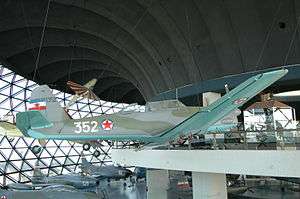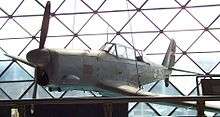Utva 213 Vihor
Utva 213 Vihor was a late 1940s Yugoslavian two-seat advanced trainer.[1]
| Vihor | |
|---|---|
 | |
| Role | Advanced military trainer |
| National origin | FPR Yugoslavia |
| Designer | Government Factories |
| First flight | 1949 |
| Introduction | 1952 |
| Retired | 1961 |
| Primary user | Yugoslav Air Force |
| Produced | 1952-54 |
| Number built | 196 |
| Developed into | Soko 522 |
Design and development
Designed and built by the Yugoslav state factory, the Type 213 was first flown in 1949, a cantilever low-wing monoplane powered by a 520 hp (388 kW) Ranger SVG-770-CB1 engine.[1] The prototype had a conventional landing gear which retracted forward, the second prototype and production aircraft had a wider track main gear that retracted inwards.[1] It had an enclosed cockpit for the instructor and student in tandem under a long glazed canopy.[1] For training the Vihor had two forward-facing machine guns and could carry up to 100 kg of bombs.[1] In 1957 an improved radial engined variant entered service as the Type 522.[1]
Survivors

One aircraft is on display at the Museum of Yugoslav Aviation, Belgrade, Serbia.
Specifications
Data from Jane's All The World's Aircraft 1956–57[2]
General characteristics
- Crew: 2
- Length: 11.52 m (37 ft 10 in)
- Wingspan: 11.0 m (36 ft 1 in)
- Height: 3.58 m (11 ft 9 in)
- Gross weight: 2,300 kg (5,071 lb)
- Powerplant: 1 × Ranger SVG-770C-1B air-cooled inverted V12 engine, 390 kW (520 hp)
Performance
- Maximum speed: 362 km/h (225 mph, 195 kn)
- Stall speed: 118 km/h (73 mph, 64 kn)
- Service ceiling: 7,000 m (23,000 ft)
Armament
- Guns: 2× machine guns
- Bombs: 2× 50 kg (110 lb) or 4× 25 kg (55 lb) bombs
References
Notes
- Orbis 1985, p. 1996
- Bridgman 1956, pp. 349–350.
Bibliography
- Bridgman, Leonard (1956). Jane's All The World's Aircraft 1956–57. New York: The McGraw Hill Book Company.
- The Illustrated Encyclopedia of Aircraft (Part Work 1982-1985). Orbis Publishing.